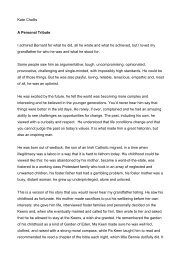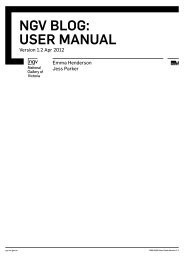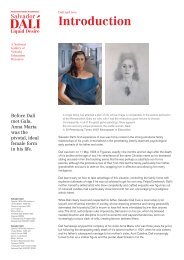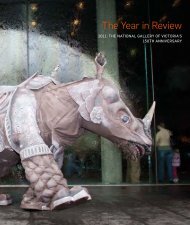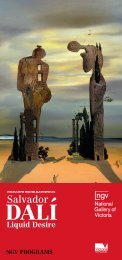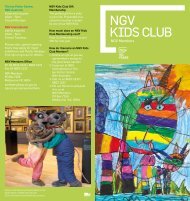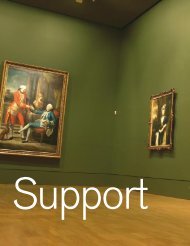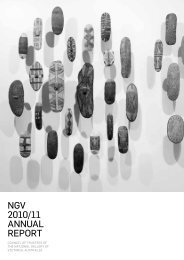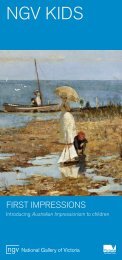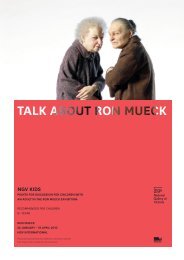EDUCATION RESOURCE - National Gallery of Victoria
EDUCATION RESOURCE - National Gallery of Victoria
EDUCATION RESOURCE - National Gallery of Victoria
You also want an ePaper? Increase the reach of your titles
YUMPU automatically turns print PDFs into web optimized ePapers that Google loves.
Animal Interactions<br />
Biographical reference<br />
Wu Zuoren had a very distinguished academic and<br />
artistic career as a painter <strong>of</strong> both traditional Chinese<br />
painting and also western painting in oil. From 1927–31<br />
he studied in Shanghai, Nanjing, France and Belgium<br />
and returned to China in 1935 to lecture in Nanjing.<br />
During the war he moved to Shanghai and organised the<br />
Shanghai Artists’ Association. Later Wu Zuoren became<br />
pr<strong>of</strong>essor at the Beijing Academy and one <strong>of</strong> China’s<br />
leading artists.<br />
Materials and techniques<br />
Research other Chinese ink and brush paintings to learn<br />
more about this technique.<br />
Describe the various techniques you think the artist may<br />
have used to manipulate the ink and brush to create the<br />
image <strong>of</strong> the panda.<br />
Find out why the artist has included calligraphy and the<br />
red seal.<br />
Issues for discussion<br />
• Pandas face a number <strong>of</strong> threats, including poaching by<br />
humans. Their habitats are also sporadic and populations<br />
are small and isolated from one another. What do you<br />
think could be done to assist in the conservation <strong>of</strong> the<br />
giant panda?<br />
• Do you think there is any<br />
significance in the underlying<br />
symbolism <strong>of</strong> the panda and the<br />
traditional contemplative nature and<br />
purpose <strong>of</strong> scroll painting?<br />
Symbolism<br />
The panda is considered a symbol<br />
<strong>of</strong> peace in China and as such was<br />
chosen as one <strong>of</strong> the mascots <strong>of</strong> the<br />
2008 Beijing Olympics, to symbolise<br />
the aspiration for a peaceful and<br />
harmonious world.<br />
Did you know?<br />
Wu Zuoren<br />
China 1908–1997<br />
Pandas and bamboo<br />
1964<br />
album: ink on paper, 8<br />
paintings, cardboard,<br />
paper, silk and gold leaf<br />
on concertina glued<br />
binding<br />
31.7 x 22.0 cm (image<br />
and sheet) (each); 31.8 x<br />
22.6 x 2.0 cm (closed);<br />
31.8 x 45.2 x 1.0 cm<br />
(open)<br />
Gift <strong>of</strong> an anonymous<br />
donor, 2007<br />
© Estate <strong>of</strong> the artist<br />
There are approximately 1,600 giant<br />
pandas estimated as still living in the<br />
wild. Giant pandas are classified as<br />
bears and may consume 12–38kg<br />
<strong>of</strong> bamboo every day to meet their<br />
energy requirements.<br />
Animal Inspirations<br />
Biographical reference<br />
Francois Pompon was born in Saulieu in Burgundy and is<br />
primarily known for his animal sculptures <strong>of</strong> the twentieth<br />
century. After his initial studies in Dijon and Paris, Pompon<br />
made his living as a sculptor’s assistant and in this<br />
capacity he served many <strong>of</strong> the prominent sculptors <strong>of</strong> his<br />
day. Pompon worked for over fifteen years with Auguste<br />
Rodin (1840–1917), translating his clay figures into<br />
marble carving.<br />
Materials and techniques<br />
This is a rare bronze version <strong>of</strong> Pompon’s first large-scale<br />
Polar bear. The work was formed from an initial clay<br />
model which was then cast in plaster. The original is now<br />
in the Musée d’Orsay in Paris.<br />
A plaster model <strong>of</strong> Polar bear was exhibited at the<br />
Salon d’Automne in 1922 and again in the 1925 Paris<br />
Exhibition Internationale des Arts Décoratifs et Industriels<br />
Modernes. Research these two important events and<br />
discover why they were significant occasions.<br />
Issues for discussion<br />
• Pompon modelled this sculpture<br />
in 1927. What may have made his<br />
sculpture so popular with so many<br />
people at this time?<br />
• Why do you think the polar bear<br />
fascinated the artist?<br />
Did you know?<br />
Polar bears are endangered due to<br />
climate change and pollution. Their<br />
Arctic habitat is melting and they risk<br />
starvation.<br />
Polar bears are also mercilessly killed<br />
by trophy hunters who are willing to<br />
pay large sums <strong>of</strong> money to shoot<br />
them. What other animals do you<br />
know that may be at risk from these<br />
causes?<br />
Symbolism<br />
Generally bears are a symbol<br />
<strong>of</strong> gentle strength, dreaming,<br />
introspection, power and protection.<br />
In recent times the polar bear has<br />
become a symbol <strong>of</strong> global warming.<br />
Compare and contrast<br />
Find Auguste Rodin’s The crying<br />
lion and compare it with Pompon’s<br />
sculpture. Is there any evidence that<br />
Pompon was influenced by Rodin in<br />
the making <strong>of</strong> his work?<br />
(Top)<br />
François Pompon<br />
France 1855–1933<br />
Claude Valsuani, Paris<br />
(foundry)<br />
France 1909–1979<br />
Polar bear<br />
(Ours blanc)<br />
(1927, cast c.1933)<br />
bronze<br />
24.2 x 44.3 x 11.6cm<br />
Purchased with the<br />
assistance <strong>of</strong> the<br />
proceeds <strong>of</strong> the 2008<br />
<strong>National</strong> <strong>Gallery</strong> <strong>of</strong><br />
<strong>Victoria</strong> Annual Dinner,<br />
2007<br />
(Left)<br />
Auguste Rodin<br />
France 1840–1917<br />
The crying lion<br />
(Le lion qui pleure)<br />
1881<br />
bronze<br />
34.4 x 35.5 x 16.9 cm<br />
(overall)<br />
Felton Bequest, 1909<br />
4 THE GALLERY ARK <strong>EDUCATION</strong> <strong>RESOURCE</strong> 5



